Drinking Water Protection
- Drinking Water Protection Home
- About Us
- A-Z Index of Contaminants in Water
- Community Public Water Supply
- Drinking Water Grants and Loans
- Drinking Water Institute
- Drinking Water in Schools and Child Cares
- Drinking Water Revolving Fund
- Laws and Rules
- Noncommunity Public Water Supply
- Source Water Protection
- Water Operator and Certification Training
- Drinking Water Protection Contacts
Related Topics
- Annual Reports
- Drinking Water Risk Communication Toolkit
- Drinking Water Protection External Resources
- Fact Sheets
- Forms
- Invisible Heroes Videos: Minnesota's Drinking Water Providers
- Noncom Notes Newsletter
- Sample Collection Procedures (videos, pictures, written instructions)
- Waterline Newsletter
Related Sites
- 10 States Standards
- Clean Water Fund
- Health Risk Assessment – Guidance Values and Standards for Water
- Minnesota Well Index
- Water and Health
- Wells and Borings
Environmental Health Division
Waterline: Spring 2017

Editor:
Stew Thornley
Subscribe to The Waterline newsletter. An e-mail notice is sent out each quarter when a new edition is posted to the web site.
On this page:
- Ellingboe Takes over as ASDWA President
- Lewis & Clark Moving through Minnesota
- Clean Water Mural Unveiled in Minneapolis
- Three Minnesotans on Blue Ribbon Commission for On-Site Non-Potable Systems
- Effluent to Beer
- St. Cloud Recognized for Source Water Protection Projects
- MDH Drafts Interconnection Policy
- Design-Build for Water/Wastewater Conference in Minneapolis March 29-31
- Fact Sheet for Permanganate Overfeeds
- MDH High-Hazard Cross Connections and Significant Deficiencies
- Cross Connections and Backflow Preventer Tracking
- The Latest on Corpus Christi
- Smithsonian Exhibit Moves to Lanesboro
- Fluoridation Equipment Improvement Grants
- 2017 Drinking Water Institute Scheduled for August 7-9
- Got a Gimmick? Got a Gadget? Bring It to the Metro School
- Asset Management Pilot in Minnesota
- Words to Live By
- Reminder to All Water Operators
- Calendar
Ellingboe Takes Over as ASDWA President
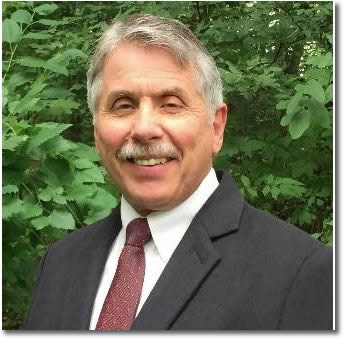 Randy Ellingboe, the manager of the Drinking Water Protection Section of the Minnesota Department of Health (MDH), is the president of the Association of State Drinking Water Administrators (ASDWA) for 2017.
Randy Ellingboe, the manager of the Drinking Water Protection Section of the Minnesota Department of Health (MDH), is the president of the Association of State Drinking Water Administrators (ASDWA) for 2017.
“We face the coming year knowing that the public, the media, and state and federal lawmakers have a high level of interest in state drinking water programs,” said Ellingboe. “We will have a new administration that will oversee EPA [Environmental Protection Agency] activities and no doubt set new priorities. We face the ongoing challenges of working with public water supply systems to ensure that the systems meet all Safe Drinking Water Act requirements and that they can address the issues brought by contaminants they may find that are unregulated, like toxins from harmful algal blooms. We continue to work to find strategies to protect our sources of drinking water. We will face problems but also find opportunities.”
Ellingboe’s predecessor, 2016 ASDWA president June Swallow said, “Randy is up to the challenge. I have gotten to know Randy over this last year and have observed that he brings a calm and thoughtful approach to problems and I am confident that he will serve ASDWA extremely well.”
Go to top
Lewis & Clark Moving through Minnesota
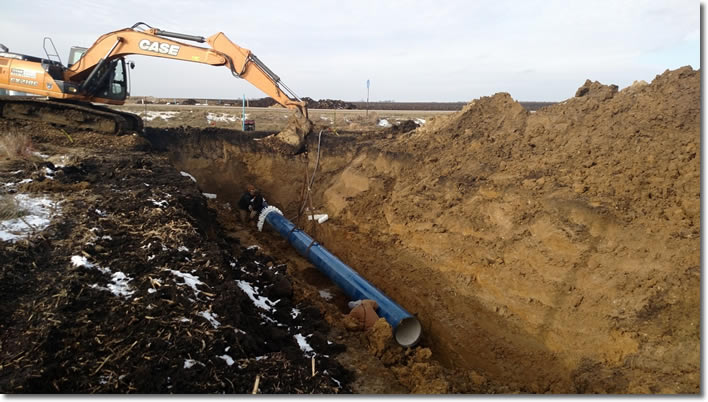 |
| Carstensen Contracting inserts a 24-inch carrier pipe into a casing that has been bored under the highway seen in the background. The work took place in mid-December near Adrian, Minnesota. |
Carstensen Contracting, Inc. of Pipestone, Minnesota, worked through the end of 2016, extending water pipes eastward through southern Minnesota as part of the Lewis & Clark Regional Water System. Conceived in 1988 as a way of serving water-challenged areas in South Dakota, Iowa, and Minnesota, the Lewis & Clark project takes water from a series of wells that tap into an aquifer adjacent to the Missouri River near Vermillion, South Dakota. The water is delivered to communities as far as 125 miles away. The project will serve approximately 300,000 people when it is completed.
The pipes first crossed into Minnesota in 2015. Recent work between Magnolia and Adrian covered a stretch with many crossings (highway, railroad, streams) that defy open-cut trenching. Instead, the contractor drilled a total of 11 horizontal bores for placement of carrier pipes to extend beneath the crossings. The streams posed a particular challenge because of the Topeka shiner—a nuisance minnow to many but an endangered species. Late-season work causes the least disturbance to the Topeka shiners’ sensitive habitat, the reason Carstensen worked into December before taking a break until spring.
The work in 2017 will continue the distribution system that includes a connection to the Lincoln-Pipestone Rural Water System, which serves a wide area that includes 38 cities in 10 counties. In addition, projects scheduled for the year include an above-ground storage reservoir and pump station south of Luverne and a meter building east of Adrian. Substantial completion of these projects in Minnesota is scheduled for next November.
“We will have a busy construction season,” said Troy Larson, executive director of the Lewis & Clark Regional Water System.
Go to top
Clean Water Mural Unveiled in Minneapolis
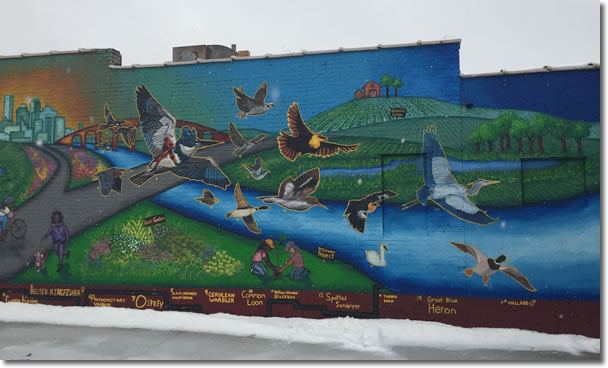 |
| A mural created by local teen artists was unveiled last November to emphasize the importance of clean water for birds and people. The mural can be seen on a building on the southeast corner of 42nd Street South and 28th Avenue East in Minneapolis. It was designed and painted by Audubon Minnesota and the Articulture Youth Arts Collaborative (YAC). Professional teaching artists worked with YAC teens to tell the story of what it means to live in a river city within the Mississippi Flyway, a major aerial highway for birds. |
Go to top
Three Minnesotans on Blue Ribbon Commission for On-Site Non-Potable Systems

Brian Davis of the Metropolitan Council, Anita Anderson of the Minnesota Department of Health, and Jon Eaton of the city of Eagan are members of the National Blue Ribbon Commission for Onsite Non-potable Water Systems. The commission—which has 30 representatives from 10 states and the District of Columbia—met in San Francisco in December for its first meeting to serve as a forum for collaboration and knowledge exchange on policies and best management practices, develop state guidance for the management and oversight of onsite non-potable systems, and identify additional research needs in the field.
Onsite water systems collect wastewater, stormwater, rainwater, and more, and treat it so that it can be reused in a building or at the local scale for non-potable needs such as irrigation, toilet flushing, and cooling. The systems are usually integrated into a city’s water and/or wastewater systems to contribute to sustainable water management by using alternate water sources, reducing valuable potable water used for non-potable purposes, and minimizing strain on wastewater systems.
“I am honored to work with such qualified and dedicated professionals on the development of best management practices to support the use of onsite non-potable water systems for individual buildings or at the local scale,” said Eaton. “We are committed to protecting public health and the environment, and sustainably managing water.”
Anderson said, “This collaboration is coming at an excellent time for Minnesota as we are in the midst of our Clean Water Fund project to advance safe and sustainable water reuse in our state. The commission provides an opportunity to both learn from and share experience with other states as we all set a path forward for reuse.”
Go to top
Effluent to Beer
You may not be able to turn sushi to gold, but a coalition called the Southwest Water Campus in Pima, Arizona, won a water innovative challenge for a statewide education campaign to get buy-in on turning effluent into a potable product.
As with any reuse effort, the challenge isn’t technological as much as it is overcoming public perception, particularly when water reuse is so often labeled “toilet to tap.”
The coalition decided to overcome the yuck factor in a different way—with beer. In partnership with brewers, the coalition is constructing a mobile potable treatment facility that will travel to Arizona cities to produce bottled water and craft beer in a series of high-profile educational events that will lead us to a national reuse conference in Phoenix in September.
Jeff Prevatt of Pima County Regional Wastewater Reclamation Department said, “Let our crisp brews change your attitudes and make Arizona more fluent about effluent.”
WateReuse Members win $250,000 Arizona Water Prize to Create Beer from Effluent
Go to top
St. Cloud Recognized for Source Water Protection Projects
St. Cloud received the 2016 Crown Community Award from American City & County magazine for pollution prevention for efforts to protect the city’s source water.
Through natural means, such as infiltration, and through other source water protection methods, the city of St. Cloud is cleaning up storm water before it reaches the Mississippi River, the city’s source for drinking water.
Like other cities, St. Cloud has separated its storm and sanitary sewers, reducing flows to its wastewater treatment plant. But through its Northeast St. Cloud Stormwater & Source Water Protection Program, the city is replicating the primary treatment that would take place in a wastewater plant, according to Lisa Vollbrecht, Assistant Public Utilities Director for St. Cloud. “We are encouraging stormwater infiltration into additional green space and rain gardens rather than directly flowing into the Mississippi River,” she explained, “and slowing down the flow so total suspended solids settle out and remove phosphorus with it.”
The project has five elements that includes the installation of an underground treatment system and several sump manholes, which have created all the environmental benefits that a traditional regional pond would provide.
St. Cloud, a central-Minnesota city of 70,000, has 6 major sub-watersheds with 27.2 square miles of the Mississippi River sub-watershed. It is the first city on the Mississippi to draw water from the river for drinking water.
St. Cloud, working with Short Elliott Hendrickson Inc., completed a drainage analysis that helped guide the city in the completion of the 2016 project elements in the Northeast sub-watershed. More than two-thirds of the $1.3 million project cost was funded through the Clean Water Land & Legacy Amendment, passed by Minnesota voters in 2008.
Go to top
MDH Drafts Interconnection Policy
Neighboring community public water systems (CPWSs) often use interconnection as a water-management strategy. While this may improve reliability and security, it is important to consider liability, costs, and unintended consequences. Physical, chemical, or hydraulic compatibilities are often forgotten elements when developing a water-sharing agreement.
In order to assist with regulatory and practical aspects of physical connections, MDH recently drafted an Interconnection Policy as a guidance to CPWSs when initiating or updating connection agreements. A key component of this policy is the definition of interconnections based on active duration: long-term is at least six months; interim is between one and six months; short-term must end within a month. In addition, any interconnecting CPWSs are expected to enter into a water-sharing agreement which addresses some or all of the following issues:
|
Water Sharing Agreement
|
|
|
Requirements
|
Recommendations
|
|
Finished water compatibility
Water age issues Water quality issues Disinfection issues Disinfection compatibility Corrosion-control compatibility Service area delineation Hydraulic analysis Communication |
Agreement review process
Agreement non-conformance Water pressure Water flow Service areas Production capacity Wholesale meter ownership Wholesale meter maintenance Costs, depreciation, and billing Service interruption management Conservation measures |
Blank copy of the Community Public Water System Interconnection Plan form: Forms
Go to top
Design-Build for Water/Wastewater Conference in Minneapolis March 29-31
American Water Works Association is one of the co-hosts with the Design-Build Institute of America’s Design-Build for Water/Wastewater Conference, which will be held at the Minneapolis Convention Center March 29-31, 2017. The conference will define, teach, and promote best practices in design-build project delivery and will focus on water and wastewater projects.
Sessions include The Future of Infrastructure and Design-Build and Utilizing Progressive Design-Build to Promote Collaboration and Innovation.
Go to top
Fact Sheet for Permanganate Overfeeds
By Jon Groethe, Minnesota Department of Health engineer
On rare occasions, an overfeed of sodium or potassium permanganate occurs at one of Minnesota’s many filtration plants, resulting in a release of pink water in parts of the distribution system. An overfeed of permanganate may be caused by a variety of operational or mechanical problems, and it is certain that customers will quickly begin calling the utility with their questions and concerns. Health risks associated with higher-than-normal levels of permanganate are usually less than with other water treatment chemicals, centering around long-term exposure rather than short-term. However, customers will strongly react to the observed pink discoloration of the water.
Finally, don’t forget to call the Minnesota State Duty Officer (800-422-0798) at the outset of a pink-water episode, so MDH Drinking Water Protection Section is informed.
Go to top
MDH High-Hazard Cross Connections and Significant Deficiencies
In response to the federal Safe Drinking Water Act’s Ground Water Rule, Surface Water Treatment Rules, and documented incidents in Minnesota, the Minnesota Department of Health classified high-hazard cross-connections that are not adequately protected as a significant deficiency (SD) for all Community Public Water Systems (CPWSs). When an SD is found during a sanitary survey performed by MDH field staff, the CPWS purveyor must correct it within 120 days.
MDH defines high-hazard cross-connections as those that would require a Reduced Pressure Zone (RPZ) backflow preventer or an air gap. However, CPWSs are strongly encouraged to adopt a more comprehensive approach by addressing all cross-connections through a cross-connection-control program. An example would be implementing one or more of the five ongoing planned activities listed in the article, Cross Connections and Backflow Preventer Tracking.
In addition, the newly adopted Minnesota Plumbing Code now requires all testable backflow devices (RPZs, pressure-type vacuum breakers, spill-proof vacuum breakers, and double-check-valve assemblies) installed on or after January 23, 2016 to be tested and inspected annually. MDH is working to propose a rule revision in the future to more fully define cross-connection-control requirements.
An effective cross-connection-control program is designed to be self-supportive, and the specific details associated with each element would be left to the each CPWS to meet its unique needs.
Go to top
Cross Connections and Backflow Preventer Tracking
By Gary McLaren, HydroCorp
Recent contamination of the public water system in Corpus Christi, Texas, demonstrates the critical need for a city-wide cross-connection-control program. It also raises the question, “Could that happen in our town?” The answer is “Yes.”
The Minnesota Administrative and Plumbing Codes specifically address cross connections in potable water systems. These codes and requirements are the foundation for good backflow prevention and cross-connection control. There is, however, additional focus needed on commonly overlooked scenarios that may leave a public water system vulnerable to backflow contamination. To address these concerns, Minnesota public water suppliers should recognize several realities about facilities connected to the public supply:
- Since plumbing codes do not require it, most buildings in Minnesota do not have a backflow preventer at the service connection/water meter.
- Not all buildings have testable backflow preventers, but all buildings do have several forms of non-testable backflow preventers, such as hose connections and air gaps.
- Backflow preventer test forms do not guarantee the building is free of unprotected cross connections.
- A backflow preventer tester typically performs only a test on the assembly and does not perform a thorough cross-connection survey of all other water piping at the facility.
While requirements and guidelines may exist on paper, the true effectiveness of a cross-connection-control program occurs when an established plan is followed on a regular basis. An example of ongoing planned activities are:
- Adopting a local ordinance requiring corrective action.
- Training water system staff/technicians in cross-connection control.
- Maintaining records that detail facility compliance.
- Performing periodic site surveys to identify unknown cross connections.
- Providing resources that enhance public awareness.
Receiving and tracking annual backflow preventer test records is a key element in a program; however, it does not address hidden cross-connection hazards within buildings. The unknown hazards are the real challenge, and with a well-rounded cross-connection-control program that includes the activities listed, safe drinking water can be better protected from backflow.
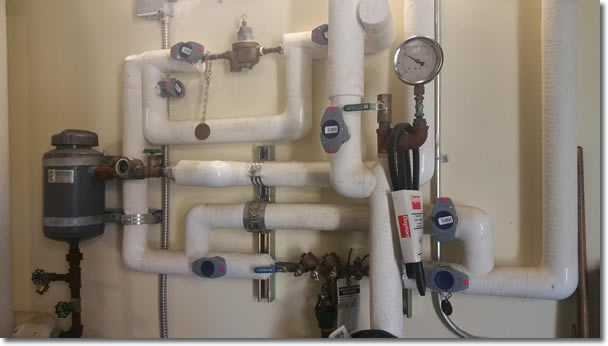 |
| This photo has a reduced-pressure-zone backflow preventer, but there also a direct cross connection. Can you spot it? |
Go to top
The Latest on Corpus Christi
Corpus Christi, Texas, had a water emergency in December 2016 when a chemical from an industrial plant—Ergon Asphalt and Emulsions Inc.—leaked into the city’s water supply, causing disruption and a run on bottled water. Although the exact cause has yet to be determined, a cross connection is suspected.
News sources quoted Corpus Christi spokeswoman Kim Womack saying that they did not find a backflow preventer at the site. “They’re [Ergon Asphalt] saying there is one and we’re telling them, ‘Show us,’” Womack said. “In the simplest terms, someone was careless when they were injecting chemicals with a pump and . . . when the injection occurred it crossed over into our water system.”
The company issued a statement the day after the problem was reported saying it has been in contact with the Texas Commission on Environmental Quality and is “working cooperatively to provide all information to ensure state officials can remedy the situation as quickly as possible.”
The U. S. Environmental Protection Agency has said it will investigate the cause of the chemical leak.
Go to top
Smithsonian Exhibit Moves to Lanesboro

The Water/Ways series of exhibits, part of the Smithsonian Institution’s Museum on Main Street program, opened in Fillmore County at the Commonweal Theatre in Lanesboro in early January for a six-week stint.
Water/Ways is a traveling exhibit that focuses on the relationships between people and water—how water connects story, history, faith, ethics, the arts, and science, all through community.
Water/Ways reveals the central nature of water in our lives by exploring how Americans use water, how water unites communities, how water affects every element of life, and how Americans care for our water and protect this valuable resource for the future.
Minnesota is one of only five states chosen by the Smithsonian to launch this new traveling exhibit. It has already been in New London/Spicer, St. Peter, Red Wing, and Sandstone.
The Becker County Historical Society in Detroit Lakes will be the last stop for the exhibit on the Minnesota tour. Water/Ways will be there until April 9.
Go to top
Fluoridation Equipment Improvement Grants
In early 2017, the MDH Drinking Water Protection Section expects to make available federal grant funds to reimburse eligible public water systems (PWSs) for equipment costs related to water fluoridation optimization. As in past years, the goal of the Fluoridation Equipment Improvement Grant will be to assist PWSs with the purchase, installation, and engineering costs of fluoridation process improvements.
However, unlike previous fluoridation grants, priority will be given to PWSs located in areas designated as dental health professional shortage areas (D-HPSA), which are designated by the U. S. Health Resources & Services Administration as having shortages of dental care, include nearly all rural Minnesota counties as well as some areas of the Twin Cities.
Visit the MDH Drinking Water Protection Grant Information page before March 2017 for grant availability, application requirements, and other details.
Go to top
2017 Drinking Water Institute Scheduled for August 7-9
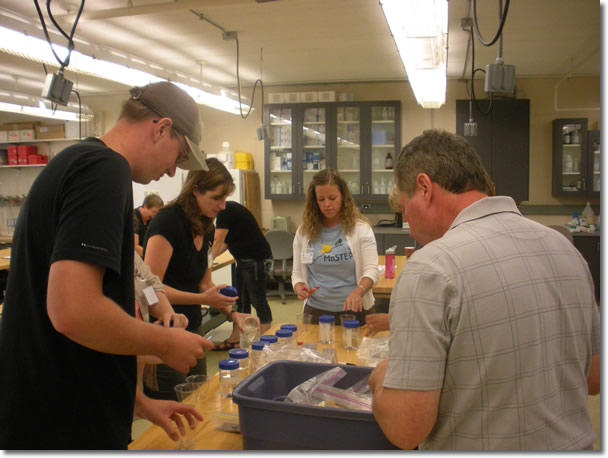
The 2017 WaterWorks! Drinking Water Institute for Educators will be held from Monday, August 7 to Wednesday, August 9 in Lakeville.
Each year Minnesota science teachers attend the three-day Institute, learning about drinking water and about ways to develop inquiry-based activities that can be incorporated into their existing science curriculum. The program is free to teachers, who receive college credit for their participation.
WaterWorks! is sponsored by the Minnesota Department of Health and the Minnesota Section of AWWA and is conducted through a partnership with Hamline University’s Center for Global Environmental Education.
More information is available on the Drinking Water Institute website
Go to top
Got a Gimmick? Got a Gadget? Bring It to the Metro School
The Metro District of the Minnesota Section of American Water Works Association (AWWA) will hold its spring school in conjunction with the Minnesota Department of Health from Monday, April 3 to Wednesday, April 5, 2017 in Brooklyn Center (see page 6). This year the school will include Gimmicks and Gadgets, an opportunity for utilities to display and demonstrate innovative devices they have made. The entries will be judged, and the winner will get a registration to the Minnesota AWWA annual conference next September with the chance to have the gimmick/gadget judged there.
Questions about Gimmicks and Gadgets may be directed to Brent Massmann, 651-675-5200.
Information on all schools: Drinking Water Protection Minnesota Water Operator Training
Go to top
Asset Management Pilot in Minnesota
Due to many of the technical, managerial, and financial (TMF) challenges faced by very small municipalities in Minnesota, the Minnesota Department of Health has chosen to use Drinking Water State Revolving Funds for technical assistance to contract with Minnesota Rural Water Association (MRWA) to provide TMF training.
Recently, MRWA was asked to create an asset management spreadsheet tailored to water systems with populations fewer than 1,000. The spreadsheet highlights the five core components of asset management and was completed in July of 2016 after being piloted on three small cities.
By collaborating with another funding source, MRWA was also able to provide a similar wastewater asset management spreadsheet.
The project will continue in state fiscal year 2017. MRWA will continue to pilot the spreadsheets with a new group of small community water systems plus provide technical assistance training on the spreadsheets.
Go to top
Words to Live By
You will never repent what you don’t misrepresent.
Life is not about how fast you run, or how high you climb, but how well you bounce.
Go to top
Reminder to All Water Operators
When submitting water samples for analyses, remember to do the following:
- Take coliform samples on the distribution system, not at the wells or entry points.
- Write the Date Collected, Time Collected, and Collector’s Name on the lab form.
- Write the Sample Point on lab forms for bacteriological and fluoride samples.
- Attach the label to each bottle (do not attach labels to the lab form).
- Include lab forms with submitted samples.
- Do not use a rollerball or gel pen; the ink may run.
- Consult your monitoring plan(s) prior to collecting required compliance samples.
Notify your Minnesota Department of Health district engineer of any e-mail changes for contact people.
If you have questions, call the Minnesota Department of Health contact on the back of all sample instruction forms.
Calendar
Operator training sponsored by the Minnesota Department of Health and the Minnesota AWWA will be held in several locations this spring.
Register for schools and pay on-line:
Go to top